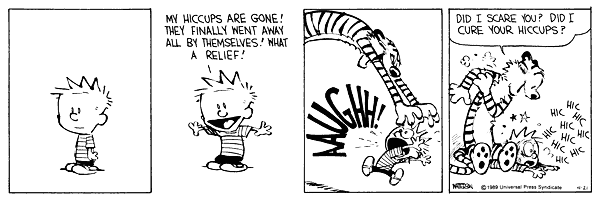I think I understand why Arthur Dent would say “I never could get the hang of Thursdays”. Why I feel the same way.
It has to do with strength and limits.
Work weeks require strength; each person is subjected to stresses, and must hold themselves together for as long as possible.
Weekends are for resting and processing things.
On Monday, the weakest people start to break down.
On Tuesday, moderately weak people start to break down, sometimes because of karma from Monday’s breakdowns, and sometimes from the fact that they can only hold it together for two days.
On Wednesday, average people start to break down, sometimes because of karma from Monday’s and Tuesday’s breakdowns, and sometimes from the fact that they can only hold it together for three days. That’s why Wednesday is Hump Day; a normal person has a fifty fifty shot of making it here without breaking down.
On Thursday, moderately strong people start to break down, sometimes because of karma built up from the week’s existing breakdowns, and sometimes from the fact that they can only hold it together for four days.
By Friday, everyone has hope, and most people have ways to coast. If a person can make it to Friday, that person is usually okay.
The strongest people rarely ever break down because they usually make it to Friday.
So “I never could get the hang of Thursdays” is something you feel if you’re a moderately strong person. You can get past Hump Day. But you might or might not make it to Friday.
—-
I feel like there are two consequences to the truth of Thursdays.
First is that Wednesday night is a great night for processing activities. If you can do a hard workout, or meet with some friends, or have a small group, you’ll blow off some of your week’s stresses and have a better chance of making it through Thursday.
Second is that, if you can’t quite get the hang of Thursdays, then Thursday deserves your special consideration. Save your focus powers for Thursday and hit it with everything you’ve got. You’re very close to being one of those people who can make it through to Friday.
—-
I think I’ve figured out the general case for having good Thursdays, at least for me, at least in this phase of my life.
Thursdays have a gravity of their own. If Thursday is the day the moderately strong break down, then it’s the day of most chaos, and thus, most external need and most unexpected opportunity!
Thursdays thus have a gravity of their own. The probability of being pulled in an unexpected direction by a need or an opportunity is high. So they’re hard days for rigid planning and goals. But if you just go with the flow, you do so little of your intended work, you feel bad.
So the trick is to have plans, treat them lightly, drop them when called, and return aggressively to them when possible, all while maintaining low expectations. And to credit yourself for reactive actions; Ben suddenly wanted to go for coffee at 9:45am. I get points for doing that instead of insisting on a prior plan. And points for jumping right back into work when we’re done.
I think I’m getting the hang of Thursdays.








